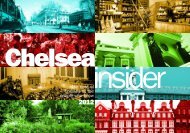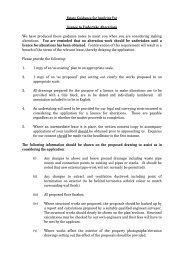Chelsea Insider Low - Cadogan
Chelsea Insider Low - Cadogan
Chelsea Insider Low - Cadogan
- No tags were found...
Create successful ePaper yourself
Turn your PDF publications into a flip-book with our unique Google optimized e-Paper software.
8 | HISTORY | A short history of <strong>Chelsea</strong>Quant and the Swinging Sixties<strong>Chelsea</strong>’s bohemian heritage returned infull force after the Second World Warwhen King’s Road became the epicentreof the pop-culture revolution.Fashion icon Mary Quant had openedBazaar, London’s first boutique, at138a King’s Road in November 1955.The operation had to be run on a shoestringat first, with Quant making all ofher clothes in her studio apartment usingfabric bought at retail price from Harrods.She railed against the “unattractive,alarming and terrifying, stilted, confinedand ugly” appearance of adults anddeveloped instead the mini-skirt andhot-pants.Along the road, at Sloane Square,the Royal Court Theatre opened JohnOsborne’s Look Back in Anger in 1956,changing the face of theatre and launchingthe idea of the ‘angry young man’ –used by the media to describe youngBritish writers, often from working ormiddle-class backgrounds, who weredisillusioned with society. It was a hugecontrast to the more traditional, genteelplays that had come before it.Another hot topic in the media wasthe group that became known as the‘<strong>Chelsea</strong> set’ – a crowd of youngsocialites headed by Quant and herhusband Alexander Plunket Greene,including wealthy pleasure-seekers andthe talented working class alike. Duringthe day they met at Bazaar, Kiki Byrne’sor one of the of coffee houses, andduring the evening they convened at theMarkham Arms or the Pheasantry beforemoving on to the house party of choice.The young and the beautiful flocked toparade themselves on King’s Roadthroughout the 1960s as the day-to-dayshops disappeared and boutiques,restaurants and cafes moved in toreplace them.With the now slightly older generationof ‘rebels with causes’, the Quants andRoyal Borough of Kensingon & <strong>Chelsea</strong>, Family & Children’s ServiceOsbornes, forming the heart of the new‘in’ scene, girls wearing mini-skirts andbell-bottom trousers mixed with touristsand the media as they all descended on<strong>Chelsea</strong>. The aim was to be seen, andKing’s Road became a world-famouscatwalk.Hedonism was the order of the day. In1966, an article in Time magazine likenedLondon to the cheerful, violent, lusty townof William Shakespeare.When the <strong>Chelsea</strong> Drugstore – anAmerican-style complex with space todrink, eat, dance and shop – opened inThe <strong>Chelsea</strong> Drugstore1968, it soon became one of the King’sRoad’s top venues. It appeared in Kubrik’sA Clockwork Orange as the ‘MusikBootick’, and was referenced in theRolling Stones song You Can’t AlwaysGet What You Want. Pressure from localresidents forced the Drugstore to shutdown in 1971.The 1970s and punksIn the early 1970s, King’s Road was ajumble of boutiques, restaurants, cafés,delicatessens, antique shops and junkshops, where the young and eager wouldGranny Takes a Tripstill migrate to shock and be shocked.It was in this setting, in 1971, thatVivienne Westwood and MalcolmMcLaren opened the first incarnationof their infamous boutique, Let It Rock,and brought about the start of a newcounter-culture: the punk movement.Let It Rock reopened in 1974 with anew name and a new sign – the word‘SEX’ emblazoned above the shop frontin PVC. As an extension of this secondincarnation of the boutique, McLarentook on the management of a new band– the Sex Pistols. They started playinggigs in the autumn of 1975 and took astand against love and peace, drugs,flared jeans, long hair and beards, alongwith anything else to do with the 1960sideology. Instead, they wore rippedT-shirts, ripped jeans, safety pins, blackleather, rubber and piercings – a lookwhich was recreated, packaged and soldby Westwood and McLaren’s boutique,which would become the face of themovement.SEX became Seditionaries, andmoved its focus further towardsbondage, and the punk movementcontinued to thrive along King’s Road.The Sex Pistols, of course, weren’t theonly punk band associated with the areaand groups like Siouxsie and theThe RoyalBorough ofKensington and<strong>Chelsea</strong>The boroughs of <strong>Chelsea</strong> andKensington were amalgamated in1965 – despite the best efforts of<strong>Chelsea</strong> residents – when localgovernment boundaries wereredrawn and 32 new Londonboroughs were created.Banshees and Generation X carried onwhat the Sex Pistols had started.The punks’ brash lifestyles oftenlanded them in trouble. Weekends wouldsee violence erupt involving punks, Teds(Teddy Boys, who wore bootlace tiesand styled their hair into quiffs) andfootball hooligans, and in July 1977members of four separate punk bandswere involved in separate incidents overthe course of a few days.Sloane RangersBecause of their loudness, it’s easy tothink that <strong>Chelsea</strong> was completelyoverrun by punks in the 1970s and early1980s, but they were very much in theminority. The eastern fringes of <strong>Chelsea</strong>had long been a seat of more conservativewealth.The fact that, by the 1980s, the term‘Sloane Ranger’ had been coined torefer to young upper-class men andwomenshows just how embedded thewealthy were in <strong>Chelsea</strong> by that time.Property and gentrificationBehind these periods of youth counterculturerevolution, more conventionalforces were driving <strong>Chelsea</strong>.After the Second World War, a resurgencein the property market meant that







